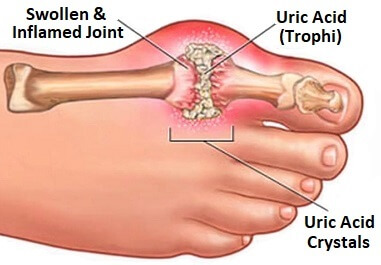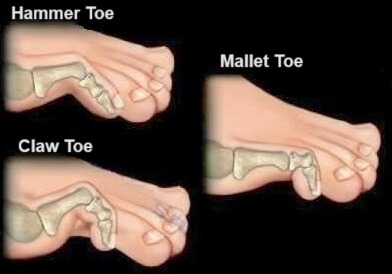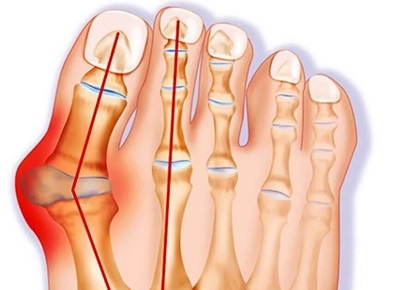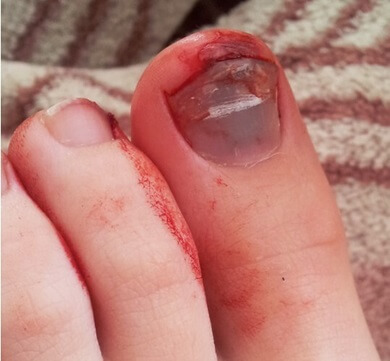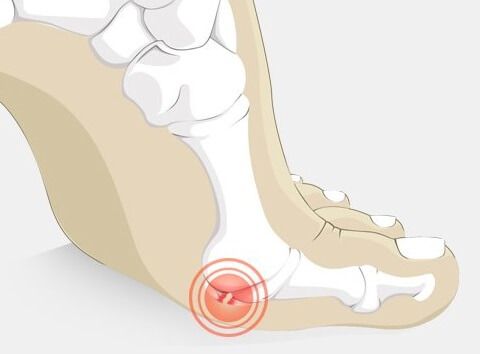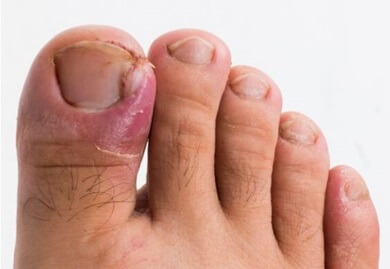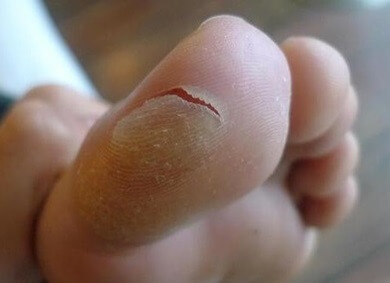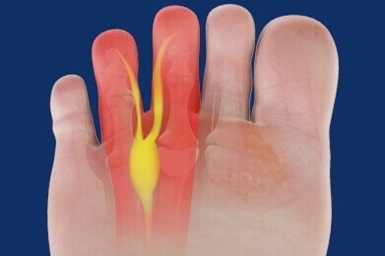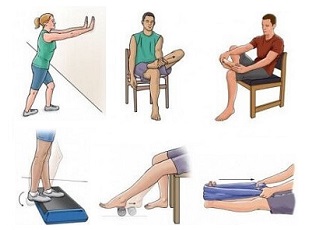- Home
- Diagnosis Guide
- Toe Pain
Toe Joint Pain
Written By: Chloe Wilson BSc(Hons) Physiotherapy
Reviewed By: FPE Medical Review Board
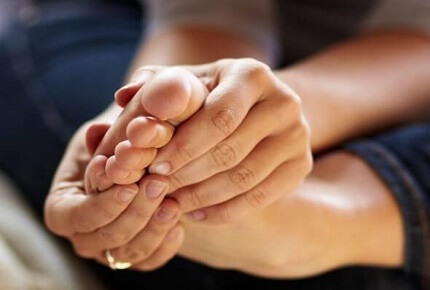
Toe joint pain is a common problem. It can affect any number of toes but most commonly causes big toe joint pain.
This is hardly surprisingly as when we walk 90% of our body weight goes through the big toe, also know as the hallux.
Toe pain may indicate problems in the bones e.g. a fracture, soft tissues e.g. tendonitis, nails e.g. ingrown toenail or skin around the toes e.g. infection. There may even be a lump on your toe.
For treatment to be effective, we need to know what the underlying cause of the problem is so we can treat that and the associated symptoms, otherwise the problem may recur.
Common Causes of Toe Joint Pain
So let's start by having a look at the most common causes of toe joint pain and how they present. You'll find a brief overview of each - to find out more, go to the full article. We will finish by looking at some of the more rare causes of toe joint pain.
1. Gout Foot
Gout foot is a common cause of toe joint pain. Gout it s type of inflammatory arthritis that typically affects the big toe causing sudden, intense pain in the toe.
Symptoms of gout foot tend to develop suddenly at night and typically include pain, inflammation, swelling, redness and heat in the big toe.
Toe joint pain from gout foot is usually caused by high levels of uric acid which casues crystals to form in the joints. High uric acid levels are usually due to diet, medication, genetics, obesity or certain medical conditions.
Repeat flare-ups are common so effective treatment is essential, not just to cure gout foot but to stop the toe joint pain returning.
If you think your toe joint pain is due to gout, you can find out loads more about the common causes, symptoms and treatment options in the Gout Foot section.
2. Hammer, Mallet & Claw Toes
Another common cause of toe joint pain is deformities in one or more of the toe joints. Depending on which joints are affected, there are different categories of toe deformities:
- Hammer Toe: where middle toe joint bends down so toe arches up
- Mallet Toe: where the tip of the toe bends down stopping the toe from straightening
- Claw Toe: where the middle and end toe joints bend down curling the toe into a claw shape - often affects multiple toes
Toe deformities can lead pain in the toe joints and in the surrounding tendons and soft tissues. Left untreated, the toes are likely to get more and more deformed but with some simple treatment, this can be delayed or even stopped altogether.
If you think your toe joint pain is due to hammer, mallet or claw toe, visit the Toe Deformities section for loads of great treatment advice
3. Foot Bunions
Bunions are another common cause of toe joint pain, particularly in the big toe. With foot bunions, the big toe gradually deviates inwards pushing the base of the toe outwards.
As a result, hard lump develops on outer side of the big toe and the toe starts to cross over neighbouring toes. Bunions may or may not be painful, depending on the severity and the positioning.
Foot bunions typically cause toe joint pain in people who wear tight, pointed, high heel shoes.
Find out more about the common causes, treatment options and prevention strategies that can help you to avoid toe joint pain in the Foot Bunions section.
4. Hallux Rigidus
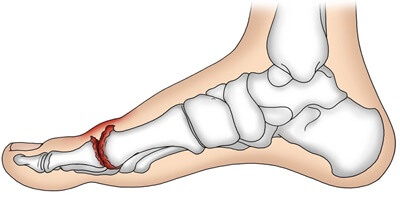
Hallux rigidus is the most common cause of big toe joint pain accompanied by stiffness.
Also known as arthritis of the big toe, hallux rigidus typically affects people over the age of 50. Wear and tear and inflammation of the metatarsophalangeal joint (MTP) between the foot and big toe results in increasing pain and stiffness in the toe. This can affect daily activities such as walking, running and climbing stairs.
Hallux rigidus progressively limits big toe movement making it difficult to push-off correctly when walking.
You can find out lots more about this common cause of big toe joint pain and stiffness including the symptoms, diagnosis and treatment options in the Hallux Rigidus section.
5. Tennis Toe
One of the less common causes of toe joint pain is Tennis Toe where there is damage to the big toe in which blood pools under the toenail
Tennis toe usually develops when the big toe repeatedly jams against the front of a shoe, which typically occurs during sporting activities where change direction quickly e.g. tennis.
Tennis toe typically causes throbbing toe joint pain and the nail will usually turn a red/black colour.
Early treatment is vital to prevent ongoing toe joint pain - you can find out more about the treatment options in the Tennis Toe section.
6. Turf Toe
Another less common causes of toe joint pain is Turf Toe where there is damage to the ligaments at the base of the big toe.
Turf toe usually results in big toe joint pain, stiffness and inflammation.
The most common cause of turf toe is a hyperextension injury where the big toe bends back too far, most typically occurring when playing sport on hard, artificial surfaces.
You can find out loads more about the common causes, treatment options and prevention strategies in the Turf Toe section.
7. Sesamoiditis
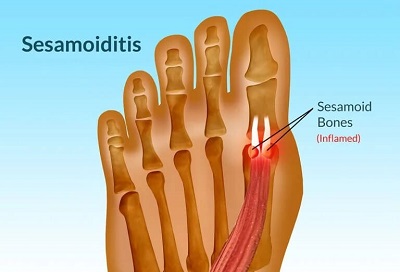
Underneath the big toe are two small pea-shaped bones, known as sesamoid bones which sit inside the tendons that run to the big toe.
They work like a pulley for the tendons to move the toe and play an important role in the push-off phase of walking.
Sesamoiditis occurs when there is inflammation of the sesamoid bones and surrounding tendons. This is usually caused by frequently wearing high-heeled shoes, activities that place lots of pressure through the ball of the foot such as ballet or suddenly increasing activity levels where you put more pressure on the ball of your foot such as running.
The most common symptoms are big toe pain, particularly underneath the toe and in the ball of the foot which develops gradually over time, comes and goes and gets worse when you are on your feet. It may be painful to move your big toe and occasionally there may be some swelling or bruising.
Treatment focuses on reducing the pressure through the area by wearing comfortable shoes, using padded shoe inserts or taping the big toe as well as reducing the big toe joint pain and inflammation with rest, regular ice treatment and occasionally a steroid injection. In rare cases, surgery may be advised.
You can find out all about the common causes, symptoms, diagnosis and treatment of sesamoid toe joint pain in the sesamoiditis section.
Other Causes Of Toe Pain
Whilst most cases of toe pain are due to a problem in one of the bones, problems with the toe nail or the skin can also cause toe pain.
Ingrown Toenail
An ingrown toe nail is where the curved edges of toenail curl and cut into the surrounding skin
Ingrown toenails cause toe pain, redness, swelling and oozing. They are usually the result of poor foot care, injury, tight shoes or incorrect nail cutting technique
But there is lots that can be done to treat ingrown toe nails - find out more in the Ingrown Toenails section.
Foot Blisters
Blisters are common causes of toe pain, particualry for those who do lots of walking. Blisters are small fluid-filled pockets form that develop on damaged areas of the upper layers of skin.
They cause a bubble-like swelling filled with fluid - clear, yellow or black to develop over the toes which can be incredibly tender.
Toe pain from blisters is typically the result of intense friction over the toe, but blisters can also develop in response to intense heat or cold, various medical conditions or exposure to certain chemicals.
You can find out loads more about the common causes and treatment options, including advice on how and when to pop blisters in the Foot Blisters section.
How To Treat Toe Joint Pain
The correct treatment for toe joint pain will depend on what is actually wrong with the foot. Typical things that help include:
- Exercises: strengthening and stretching the foot and ankle
- Orthotics: inserts for your shoes to correct foot position
- Steroid Injections: to reduce pain and inflammation
- Ice Packs: to reduce pain and inflammation
- Supports: tubigrip compression bandage or ankle/foot supports of splints
- Toe Stretchers: specially designed inserts that sit between your toes
You can find out lots more about the treatment options for each of these types of toe joint pain by reading the full articles mentioned above.
Rare Causes of Toe Joint Pain
There are a number of other less common causes of toe pain, which we will look at now.
Morton’s Neuroma
Morton’s Neuroma is a condition affecting the nerves that run between the toes, causing toe joint pain, tingling and numbness between your toes and underneath the foot.
Many people complain that it feels like there is a small stone underneath their foot.
Morton’s neuroma is caused by a thickening in the tissue which surrounds the nerve which irritates and compresses the nerve. This may be due to other foot problems such as bunions, hammertoe and flat feet or wearing tight or high-heeled shoes.
It most commonly develops between the 3rd and 4th toe, but can occur between the 2nd and 3rd toe.
Treatment consists of rest, painkillers, injections, orthotics (shoe insoles) and occasionally surgery.
Full Article: Morton's Neuroma: Causes, Symptoms & Treatment
Toe Arthritis
Arthritis is another possible cause of toe joint pain. The most common place to get arthritis in the foot is at the base of the big toe in the metatarsophalangeal joint (MTPJ).
The big toe is continually bending up and down as we walk making it prone to wear and tear. With arthritis, the cartilage that lines the MTPJ gets damaged and osteophytes (small lumps of bone) form. This results in stiffening of the big toe, known as hallux rigidus.
Common symptoms of arthritis include big toe joint pain, especially during the push-off phase of walking, inflammation and stiffness limiting how much the big toe can bend up. A bunion may develop on the toe.
Toe arthritis may be linked with foot injuries or episodes of gout, but often develops with no obvious cause. Treatment consists of pain relief, ice, steroid injections and orthotics such as a rocker bar which fit on the sole of your shoe so you don’t have to bend the toe up when walking.
If symptoms get progressively worse, surgery may be required to either trim some of the bone, fuse the joint or replace it altogether with a prosthesis.
Other rare causes of toe joint pain include:
- Fractures: A break in one the toe bones either from trauma or repetitive stress
- Blue Toe Syndrome: A condition where a blockage in the small blood vessels of the foot reduces blood and oxygen flow. The toes characteristally turn blue and are extremely painful
- Vascular Disease: Narrowing of the arteries reducing the blood and oxygen flow to the legs and feet
- Toenail Problems: Thickening and discolouration of the toenails may be due to a fungal infection or underlying medical condition
- Diabetes: People with diabetes are more susceptible to foot problems due to damage to the blood vessels and peripheral nerves
- Capsulitis: Inflammation of the joint capsule, the fluid filled sac that surrounds the synovial joints of the toes
- Tumours: Tumours in the foot bones are extremely rare accounting for 3-6% of all bone tumours
- Digital Mucous Cysts: small fluid-filled lumps that can form by or near the toe nails
Toe Joint Pain Summary
Toe joint pain is a common problem that may come on suddenly or gradually.
There may be a problem in the one or more of the toe bones e.g. mallet toe or bunions, the toenail e.g. tennis toe, the ligaments e.g. turf toe or an underlying medical condition e.g. gout.
There are a number of different treatment options depending on the underlying cause which may involve exercises, orthotics, injections, ice and toe stretchers.
If your pain is spreading to the rest of the foot, visit the foot pain diagnosis section for help working out what is causing your pain or check out the following articles:
Related Articles
Page Last Updated: 11/08/23
Next Review Due: 11/08/25
